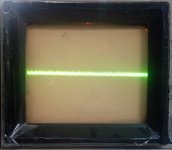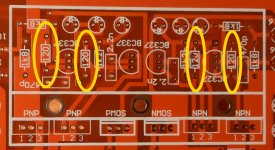Hi all!
I need some help, please.
So, finally, after a year, I built my Paradise, installed in the cases and ran it. It started instantly, beautiful sounds coming out of my speaker.
Great, but I do have two boring problems.
1. HUM, no matter the distance between the prereg case and the preamp case. It's audible with the volume knob at 11 o'clock. This hum (or another hum!!!) increases a lot when I come closer with the prereg box to the other box.
Solution: I'll change the two transformers I use right now - Triads EI type with two encapsulated toroid. I fear that There are two types of hum hear: one from a ground loop, not being changed by the replacement of the transfromers, and the other, that it's generated by the magnetic field of the current transformers. I'll report back after the change.
2. HISS. Well that's boring. The hum man can probably get rid of, but the hiss, I don't know. That's why I really need help.
It's also audible with the volume knob at 11 o'clock. At normal levels of audition, (till 9 -10 o'clock) it's not possible to hear it.
Strange behavior of the preamp: each time I power on the preamp, a very strong hiss, like a strong wind, like a waterfall, very audible at low level, can be heard in the speakers. After a while, circa 2 minutes, these noises decrease, remaining only the hiss described above. Is this normal for this amplifier? It occurs only in the heat up period of the electronics, and the stabilization of the voltages?
Solution: If I can leave with the strong noise that disappears after two minutes, I find the hiss not be compatible with this fine preamp. Is this caused oscillations? The transistors are very well matched. Is the Calvin Buffer causing this? Or rather my bad implementation of this buffer?
So, please help!
Emil
Hi Emil
I have the Paradise with Calvin buffers fitted and TBH it's the quietest phono pre that I've ever heard. Yours is playing music which is great and I'm sure that it's going to just take a little more work to get it running quietly.
Firstly did you fit the DDRC circuit as outlined in Frans grounding guide? I have a friend who had the same hum problem but after re wiring his ground lines and fitting the DDRC the problem was solved. If you've not done so already then that may be a good place to start.
The strange pre amp problem.
Sounds to me like you are listening to the sound of the caps charging and the circuit settling. I usually switch my Paradise on first and give it few minutes to settle before switching on the rest of the system.
Anyhow
Some pictures of your build (pre and power boxes) may help just to see if it’s anything obvious but easy to miss.
I suspect that it’s going to be something small and easy to fix but let’s see.
Just a small step needed to Paradise.😀
Hi all!
I need some help, please.
So, finally, after a year, I built my Paradise, installed in the cases and ran it. It started instantly, beautiful sounds coming out of my speaker.
Great, but I do have two boring problems.
1. HUM, no matter the distance between the prereg case and the preamp case. It's audible with the volume knob at 11 o'clock. This hum (or another hum!!!) increases a lot when I come closer with the prereg box to the other box.
Solution: I'll change the two transformers I use right now - Triads EI type with two encapsulated toroid. I fear that There are two types of hum hear: one from a ground loop, not being changed by the replacement of the transfromers, and the other, that it's generated by the magnetic field of the current transformers. I'll report back after the change.
2. HISS. Well that's boring. The hum man can probably get rid of, but the hiss, I don't know. That's why I really need help.
It's also audible with the volume knob at 11 o'clock. At normal levels of audition, (till 9 -10 o'clock) it's not possible to hear it.
Strange behavior of the preamp: each time I power on the preamp, a very strong hiss, like a strong wind, like a waterfall, very audible at low level, can be heard in the speakers. After a while, circa 2 minutes, these noises decrease, remaining only the hiss described above. Is this normal for this amplifier? It occurs only in the heat up period of the electronics, and the stabilization of the voltages?
Solution: If I can leave with the strong noise that disappears after two minutes, I find the hiss not be compatible with this fine preamp. Is this caused oscillations? The transistors are very well matched. Is the Calvin Buffer causing this? Or rather my bad implementation of this buffer?
So, please help!
Emil
I am not terribly experienced in builds, and have little technical knowledge, so more than answers these are question/suggestions.
First I would tend to think hum is related to transformers and/or ground, have you tried other transformers ??
Second, regarding hiss, could this be related to cartridge - phono stage loading ?? As I understand that wrong loading can cause problems.
Saludos
Manolo
Thank you all.
I'll come with photos soon.
Regarding the DDRC, I use it but wired differently, according to a schematic found on internet, (can't rember the author). Not big difference but I'll try to stick with Frans implementation.
I put the DDRC in the pre reg case close to the IEC mains socket. Is it right?
Ok, let's talk again after attaching the photos.
Emil
I'll come with photos soon.
Regarding the DDRC, I use it but wired differently, according to a schematic found on internet, (can't rember the author). Not big difference but I'll try to stick with Frans implementation.
I put the DDRC in the pre reg case close to the IEC mains socket. Is it right?
Ok, let's talk again after attaching the photos.
Emil
To Manolo
I'll try replacing the transformers with encapsulated torroids. But this only friday or saturday.
I use the loading selector as recomended by Alfred. The hiss doesn't disappear or change in any kind when selecting, only the volume and the tone of the sound(? it's only an impression).
Emil
I'll try replacing the transformers with encapsulated torroids. But this only friday or saturday.
I use the loading selector as recomended by Alfred. The hiss doesn't disappear or change in any kind when selecting, only the volume and the tone of the sound(? it's only an impression).
Emil
‘’I put the DDRC in the pre reg case close to the IEC mains socket. Is it right?’’
Hi Emil
Yes that’s correct but I really would be tempted to use the exact implementation as outlined by Frans in the build guide if only to start from a known place.
But yes let’s start from some photo’s.
Hi Emil
Yes that’s correct but I really would be tempted to use the exact implementation as outlined by Frans in the build guide if only to start from a known place.
But yes let’s start from some photo’s.
Hi Folks, little bug fix, can be found here: http://www.diyaudio.com/forums/group-buys/216891-paradise-phono-stage-130.html#post3911084
Why Paradise uses 10nf+10nf+10nf+3nf+300pf instead of available 33nf Wima FKP2 capacitor? Was it intention to reduce parasitic inductance?
The intention was for you to measure and match the caps so the vaues match perfectly between the channels. But you can use single caps as you want, no problem. There were about 500 different requests for caps that we decided in the team to just put some footprints and let everybody populate as they want
(this is also called the path of least resistance 😀 )
Hi all!
I need some help, please.
So, finally, after a year, I built my Paradise, installed in the cases and ran it. It started instantly, beautiful sounds coming out of my speaker.
Great, but I do have two boring problems.
1. HUM, no matter the distance between the prereg case and the preamp case. It's audible with the volume knob at 11 o'clock. This hum (or another hum!!!) increases a lot when I come closer with the prereg box to the other box.
Solution: I'll change the two transformers I use right now - Triads EI type with two encapsulated toroid. I fear that There are two types of hum hear: one from a ground loop, not being changed by the replacement of the transfromers, and the other, that it's generated by the magnetic field of the current transformers. I'll report back after the change.
2. HISS. Well that's boring. The hum man can probably get rid of, but the hiss, I don't know. That's why I really need help.
It's also audible with the volume knob at 11 o'clock. At normal levels of audition, (till 9 -10 o'clock) it's not possible to hear it.
Strange behavior of the preamp: each time I power on the preamp, a very strong hiss, like a strong wind, like a waterfall, very audible at low level, can be heard in the speakers. After a while, circa 2 minutes, these noises decrease, remaining only the hiss described above. Is this normal for this amplifier? It occurs only in the heat up period of the electronics, and the stabilization of the voltages?
Solution: If I can leave with the strong noise that disappears after two minutes, I find the hiss not be compatible with this fine preamp. Is this caused oscillations? The transistors are very well matched. Is the Calvin Buffer causing this? Or rather my bad implementation of this buffer?
So, please help!
Emil
Hi Emil, you must be one of the fastest builders out there - I just shipped the PCBs a few weeks ago.... Amazing!!
The hiss you describe sounds like the power supply is oscillating. It will be important to look at the rail voltages, as Ricardo described, with an oscilloscope. There may be some ripple voltage at high frequency (several MHz) there.
Please let us know what you find!
Hi,
I'm the laziest of builders ever. These were the boards bought last year in April.
However, I come with one photo showing one 18 V rail on the scope. It was an ancient Russian oscilloscope but with 100 or 150 MHz. I may use another scope more recent but with only 35 MHz - it's better?
The amplitude of what you see is 25 mV.
Is this oscillation? Or just noise of the supply. Is this causing the hiss in the audio path?
I don't know very well how to use an oscilloscope, that's clear.
Emil
I'm the laziest of builders ever. These were the boards bought last year in April.
However, I come with one photo showing one 18 V rail on the scope. It was an ancient Russian oscilloscope but with 100 or 150 MHz. I may use another scope more recent but with only 35 MHz - it's better?
The amplitude of what you see is 25 mV.
Is this oscillation? Or just noise of the supply. Is this causing the hiss in the audio path?
I don't know very well how to use an oscilloscope, that's clear.
Emil
Attachments
My 2c, like I said before I think you should check your cartridge loading, mismatched loads can raise the 10k hz to 20k hz audio range, and from my experience hiss is like increasing treble, which is exactly this.
Discussion on MC Cartridge Loading
Hagerman Technology LLC: Cartridge Loading
Magnetic Phono Pickup Cartridges
Three links that discuss this. Improper loading can raise this range up to 4 db, which is meaningful. I guess I would try connecting the paradise to the amp without having it connected to the turntable to see if there is any difference.
Saludos,
Manolo
Discussion on MC Cartridge Loading
Hagerman Technology LLC: Cartridge Loading
Magnetic Phono Pickup Cartridges
Three links that discuss this. Improper loading can raise this range up to 4 db, which is meaningful. I guess I would try connecting the paradise to the amp without having it connected to the turntable to see if there is any difference.
Saludos,
Manolo
Post347-
That looks like noise. But at 25mVpp is far too high for a supply rail.
You should see less than 5mVpp and preferably less than 2mVpp.
That looks like noise. But at 25mVpp is far too high for a supply rail.
You should see less than 5mVpp and preferably less than 2mVpp.
Hi
I come back with some photos.
First new measurements with another scope.
1. First screen: +/-26 V measured between pre-reg and shunt on the input power socket of preamp case.
2. Second screen: +/- 18 V measured between shunt and preamp
3. Third screen: audio output left channel.
You may read the settings of the oscilloscope in the photos.
Second, some photos inside the pre-reg case.
Question: It's possible to have oscillation from the pre-regulator, as it seems to show the first screen? Unfortunatelly I didn't verifiy the pre-reg without the shunt connected, so without any load in order to see if the signal shape sown in the screen 1 is the same.
Is anything wrong with the way I buit the pre-reg or the parts I choose?
I come back with some photos.
First new measurements with another scope.
1. First screen: +/-26 V measured between pre-reg and shunt on the input power socket of preamp case.
2. Second screen: +/- 18 V measured between shunt and preamp
3. Third screen: audio output left channel.
You may read the settings of the oscilloscope in the photos.
Second, some photos inside the pre-reg case.
Question: It's possible to have oscillation from the pre-regulator, as it seems to show the first screen? Unfortunatelly I didn't verifiy the pre-reg without the shunt connected, so without any load in order to see if the signal shape sown in the screen 1 is the same.
Is anything wrong with the way I buit the pre-reg or the parts I choose?
Attachments
-
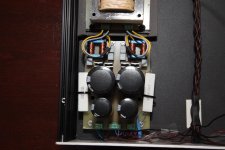 Paradise 010 (Medium).jpg126.7 KB · Views: 231
Paradise 010 (Medium).jpg126.7 KB · Views: 231 -
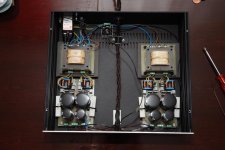 Paradise 009 (Medium).jpg122.6 KB · Views: 226
Paradise 009 (Medium).jpg122.6 KB · Views: 226 -
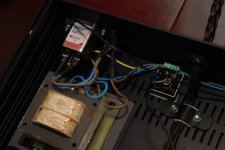 Paradise 008 (Medium).jpg102.9 KB · Views: 173
Paradise 008 (Medium).jpg102.9 KB · Views: 173 -
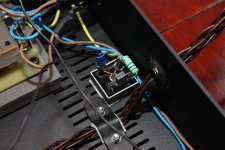 Paradise 007 (Medium).jpg134 KB · Views: 176
Paradise 007 (Medium).jpg134 KB · Views: 176 -
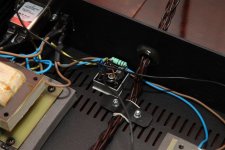 Paradise 006 (Medium).jpg116.4 KB · Views: 175
Paradise 006 (Medium).jpg116.4 KB · Views: 175 -
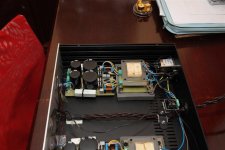 Paradise 005 (Medium).jpg114.6 KB · Views: 451
Paradise 005 (Medium).jpg114.6 KB · Views: 451 -
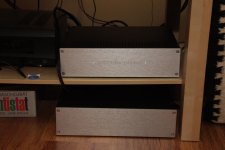 Paradise 004 (Medium).jpg90.8 KB · Views: 562
Paradise 004 (Medium).jpg90.8 KB · Views: 562 -
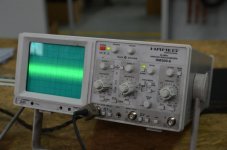 DSC_7994 (Medium).JPG111.9 KB · Views: 560
DSC_7994 (Medium).JPG111.9 KB · Views: 560 -
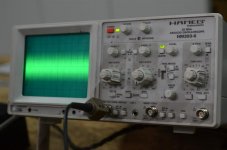 DSC_7993 (Medium).JPG110.9 KB · Views: 563
DSC_7993 (Medium).JPG110.9 KB · Views: 563 -
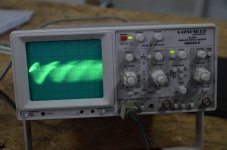 DSC_7984 (Medium).JPG113 KB · Views: 572
DSC_7984 (Medium).JPG113 KB · Views: 572
Second batch of photos.
Showing inside the case of the preamp.
Is anything wrong? I didn't use shielded cables neither from the input RCA to the pCB, nor from PCB to the Calvin or to the output RCA. Wrong?
I tried to thermocouple the groups of transistors in a personal way, leading to longer legs of the transistors or crossing them. Wrong?
To the star point I came with the wire of the tonearm rounding, the ground of the input RCA sockets and this sort of shield/thermocoupling of the input transistors. It's OK?
I took the common directly onto the input power socket by the two 10 ohm resistors. Should I have took the common rather from the star point, or another point in the PCB.
Any suggestion or advise would be appreciated.
Thanks all for your support.
Emil
Showing inside the case of the preamp.
Is anything wrong? I didn't use shielded cables neither from the input RCA to the pCB, nor from PCB to the Calvin or to the output RCA. Wrong?
I tried to thermocouple the groups of transistors in a personal way, leading to longer legs of the transistors or crossing them. Wrong?
To the star point I came with the wire of the tonearm rounding, the ground of the input RCA sockets and this sort of shield/thermocoupling of the input transistors. It's OK?
I took the common directly onto the input power socket by the two 10 ohm resistors. Should I have took the common rather from the star point, or another point in the PCB.
Any suggestion or advise would be appreciated.
Thanks all for your support.
Emil
Attachments
-
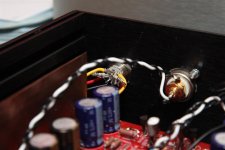 Paradise 026 (Medium).jpg93.2 KB · Views: 175
Paradise 026 (Medium).jpg93.2 KB · Views: 175 -
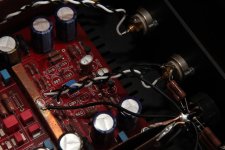 Paradise 031 (Medium).jpg113.4 KB · Views: 156
Paradise 031 (Medium).jpg113.4 KB · Views: 156 -
 Paradise 029 (Medium).jpg123.3 KB · Views: 163
Paradise 029 (Medium).jpg123.3 KB · Views: 163 -
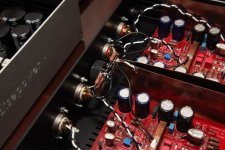 Paradise 021 (Medium).jpg138 KB · Views: 173
Paradise 021 (Medium).jpg138 KB · Views: 173 -
 Paradise 018 (Medium).jpg149.7 KB · Views: 180
Paradise 018 (Medium).jpg149.7 KB · Views: 180 -
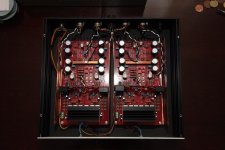 Paradise 017 (Medium).jpg117.2 KB · Views: 214
Paradise 017 (Medium).jpg117.2 KB · Views: 214 -
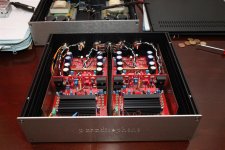 Paradise 016 (Medium).jpg142.1 KB · Views: 201
Paradise 016 (Medium).jpg142.1 KB · Views: 201 -
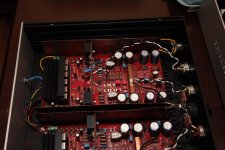 Paradise 015 (Medium).jpg125 KB · Views: 188
Paradise 015 (Medium).jpg125 KB · Views: 188 -
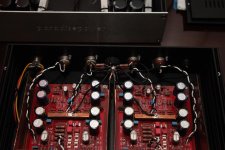 Paradise 014 (Medium).jpg132.4 KB · Views: 206
Paradise 014 (Medium).jpg132.4 KB · Views: 206 -
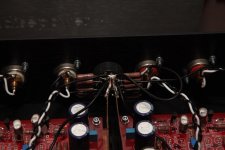 Paradise 012 (Medium).jpg98 KB · Views: 181
Paradise 012 (Medium).jpg98 KB · Views: 181
Hi Emil, your build looks fine, I could not spot any apparent issue. Also the grounding is looking OK (although I could not understand the phrase about the two 10 Ohm resistors).
You should try and play with the "TIME/DIV" setting until you can see a clear oscillation, and determine the frequency. If it is below 10MHz, it will probably be the CCS, and if it is 60-80MHz, it is the amplifier (athough I doubt it).
Please try and put a film cap of 1uF on the rail right where you put the oscilloscope probe, and see if the noise gets less. If it does, it would indicate that you actually have oscillations. If it does not, your test setup is not OK, and you have other noise sources in the room (think computer, monitor, fluorescent lamp, cellphone, .....)
good luck in hunting!
alfred
You should try and play with the "TIME/DIV" setting until you can see a clear oscillation, and determine the frequency. If it is below 10MHz, it will probably be the CCS, and if it is 60-80MHz, it is the amplifier (athough I doubt it).
Please try and put a film cap of 1uF on the rail right where you put the oscilloscope probe, and see if the noise gets less. If it does, it would indicate that you actually have oscillations. If it does not, your test setup is not OK, and you have other noise sources in the room (think computer, monitor, fluorescent lamp, cellphone, .....)
good luck in hunting!
alfred
Hi guys, sorry for the confusion, there was an issue with the link list, its all fixed now and the new BOM is accessible. We reduced the 330Ohm resistors when we discovered the CCS might oscillate, and the new boards have this printed on them, as the picture below shows.
Older boards still had "330" printed there, no worries to keep them as they are if the regulators are not oscillating.....
happy bastling
alfred
Older boards still had "330" printed there, no worries to keep them as they are if the regulators are not oscillating.....
happy bastling
alfred
Attachments
I populated my R3 boards a while back, with the 330 ohms. Will try to reduce them to 120 ohms and report back if this stops the oscillations... Thank you Alfred!
Just built up another set and one board is fine with about 100mv across RIAA ext, the other is currently showing about 3.5v here and at the output. I'm guessing my buffer is fried. Any suggestions on what to look for, the op-amps are the 2140s on adaptors.
Just swapped them out for the old one, no DC on output, only 50mv across RIAA EXT. So much for progress.
adjusting the buffer offset should bring both the output to zero (which is done through the servo) and the RIAA EXT (which must be zero if the buffer offset is zero, because of the servo....) So I hope this is what you are seeing.
For the fried buffer, check the input transistors (PF5102). And, you may want to verify the pinout of the output bipolars, it just so easily happens that they are assembled the wrong way.....
For the fried buffer, check the input transistors (PF5102). And, you may want to verify the pinout of the output bipolars, it just so easily happens that they are assembled the wrong way.....
- Home
- Source & Line
- Analogue Source
- Paradise Builders
